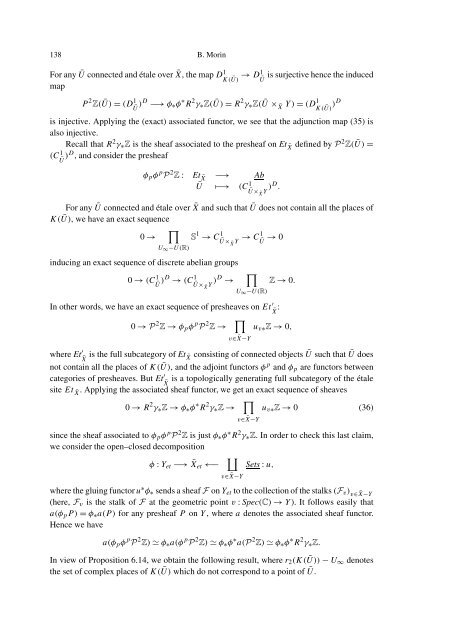THE WEIL-´ETALE FUNDAMENTAL GROUP OF A NUMBER FIELD I
THE WEIL-´ETALE FUNDAMENTAL GROUP OF A NUMBER FIELD I
THE WEIL-´ETALE FUNDAMENTAL GROUP OF A NUMBER FIELD I
Create successful ePaper yourself
Turn your PDF publications into a flip-book with our unique Google optimized e-Paper software.
138 B. Morin<br />
For any Ū connected and étale over ¯X,themapD 1 K(Ū) → D1 is surjective hence the induced<br />
Ū<br />
map<br />
P 2 Z(Ū)= (D 1 Ū )D −→ φ ∗ φ ∗ R 2 γ ∗ Z(Ū)= R 2 γ ∗ Z(Ū × ¯X Y)= (D1 K(Ū) )D<br />
is injective. Applying the (exact) associated functor, we see that the adjunction map (35) is<br />
also injective.<br />
Recall that R 2 γ ∗ Z is the sheaf associated to the presheaf on Et ¯X defined by P2 Z(Ū)=<br />
(C 1 Ū )D , and consider the presheaf<br />
φ p φ p P 2 Z : Et ¯X −→ Ab<br />
Ū ↦−→ (C 1 Ū× ¯X Y )D .<br />
For any Ū connected and étale over ¯X and such that Ū does not contain all the places of<br />
K(Ū), we have an exact sequence<br />
0 → ∏<br />
S 1 → C 1 Ū× ¯X Y → C1 Ū → 0<br />
U ∞ −U(R)<br />
inducing an exact sequence of discrete abelian groups<br />
0 → (C 1 Ū )D → (C 1 Ū× ¯X Y )D → ∏<br />
U ∞ −U(R)<br />
Z → 0.<br />
In other words, we have an exact sequence of presheaves on Et ′¯X :<br />
0 → P 2 Z → φ p φ p P 2 Z → ∏<br />
u v∗ Z → 0,<br />
v∈ ¯X−Y<br />
where Et ′¯X is the full subcategory of Et ¯X consisting of connected objects Ū such that Ū does<br />
not contain all the places of K(Ū), and the adjoint functors φ p and φ p are functors between<br />
categories of presheaves. But Et is a topologically generating full subcategory of the étale<br />
′¯X<br />
site Et ¯X . Applying the associated sheaf functor, we get an exact sequence of sheaves<br />
0 → R 2 γ ∗ Z → φ ∗ φ ∗ R 2 γ ∗ Z → ∏<br />
u v∗ Z → 0 (36)<br />
v∈ ¯X−Y<br />
since the sheaf associated to φ p φ p P 2 Z is just φ ∗ φ ∗ R 2 γ ∗ Z. In order to check this last claim,<br />
we consider the open–closed decomposition<br />
φ : Y et −→ ¯X et ←−<br />
∐<br />
Sets : u,<br />
v∈ ¯X−Y<br />
where the gluing functor u ∗ φ ∗ sends a sheaf F on Y et to the collection of the stalks (F v ) v∈ ¯X−Y<br />
(here, F v is the stalk of F at the geometric point v : Spec(C) → Y ). It follows easily that<br />
a(φ p P)= φ ∗ a(P) for any presheaf P on Y ,wherea denotes the associated sheaf functor.<br />
Hence we have<br />
a(φ p φ p P 2 Z) ≃ φ ∗ a(φ p P 2 Z) ≃ φ ∗ φ ∗ a(P 2 Z) ≃ φ ∗ φ ∗ R 2 γ ∗ Z.<br />
In view of Proposition 6.14, we obtain the following result, where r 2 (K(Ū))− U ∞ denotes<br />
the set of complex places of K(Ū) which do not correspond to a point of Ū.

















